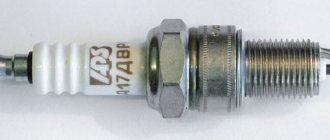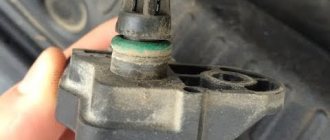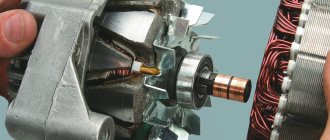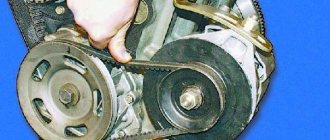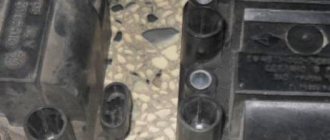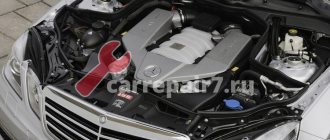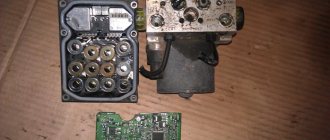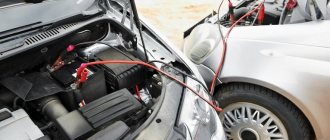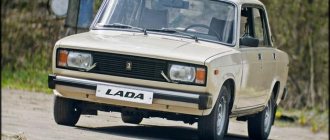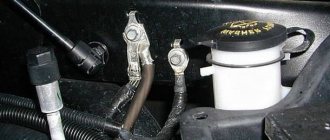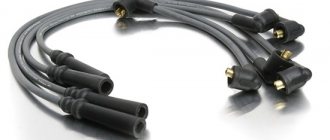Wires for lighting a car are an indispensable thing, especially in the cold season in Russia.
In winter, almost every driver has had this problem when the car won’t start - the battery is dead or faulty. This can happen due to an old battery, headlights not being turned off in time, or the radio being left on. Severe frost also negatively affects the battery's electrical capacity. In such an unpleasant situation, a donor car can come to the rescue and start your car, and you can drive to a place where you can recharge or change the battery.
Why do you need wires for lighting?
Wires for lighting a car (or starting wires) already from their name determine their purpose - to supply energy sufficient to start the car from the battery of one car to another. That is, you start your car using the battery of someone else's car. Wires for lighting must have the necessary characteristics:
- must be able to withstand the large current that passes through them during startup;
- should not lose their properties in severe frosts, when they are most in demand;
- the wires must provide high-quality contact.
Therefore, you should pay attention to the materials from which the wires are made, since they are subject to certain requirements.
Mid-price segment products
Autoprofi APBC5000XL
The length of the wires for lighting is 3.5 meters. It is very convenient to use for charging batteries in both trucks and cars. Operates in severe frosts and hot weather. Does not break or crack. Lasts quite a long time. The clamps are durable and high quality.
The average price is 1550 rubles.
wires Autoprofi APBC5000XLAdvantages:
- ease of use;
- optimal length;
- positive reviews;
- value for money;
- safety.
Flaws:
- none.
Battery Vympel 146227
The product is produced by a Russian enterprise. The current indicator is 500 A, length 3 meters with a diameter of 10 mm. Consists of 94 cores. Designed for operation at temperatures from 50 degrees below zero to 80 degrees above zero. It is safe and has a long service life. Made from quality materials.
The purchase price is 1,794 rubles.
battery wires Vympel 146227Advantages:
- ease of use;
- durability;
- functionality;
- versatility.
Flaws:
- not installed.
Stels 55919
The product is manufactured to perform this task - to additionally recharge the starter in a vehicle if its own battery is completely dead or the oil has frozen in severe frost. The length of the product is 2.5 meters, it operates with a current of 400 A. It will become an indispensable assistant for starting cars and trucks.
Purchase price – 1330 rubles.
wires Stels 55919Advantages:
- versatility;
- practicality;
- functionality;
- durability.
Flaws:
- none.
Astro Smart PLU
The model is in great demand due to its complete safety and reliability in operation. Even if a polarity reversal or contact shorting occurs, the driver will never be shocked due to the presence of safe clamps. If an emergency occurs, there will be no negative impact on the electrical systems. The manufacturer has equipped its brainchild with special LED indicators that will let you know whether you have connected the wires to the terminals correctly. The ends are connected separately, so even if the cables touch each other, a short circuit will not occur. Capable of passing a current of 400 A. The thickness of the cores is 6 mm. The wire is 5.3 meters long. The manufacturer guarantees a service life of 10 years.
Purchase price – 1300 rubles.
Astro Smart PLU wiresAdvantages:
- safety;
- reliability;
- versatility;
- functionality;
- positive user reviews;
- value for money.
Flaws:
- not installed.
Wires for lighting
The wires for lighting a car have a simple structure and consist of:
- stranded copper wire enclosed in durable frost-resistant insulation;
- and alligator clips are installed at both ends.
Starting current
When starting a car, the battery has to give off energy in very large quantities to turn the engine. If we are talking about a car with an engine of up to 1.5 liters, then the minimum starting currents reach 200 A. If the engine is more powerful, then the starting currents can reach 400 A. In severe frost, when the oil thickens, it is even harder for the starter to crank the engine and the currents are higher.
Naturally, in order to pass such currents, the wires for lighting must have stranded, high-quality wire of the appropriate cross-section. The amount of current that needs to be passed through the wire depends on its resistance.
The wire resistance depends on:
- material - the lower the resistivity of the wire, the lower the overall resistance;
- diameter - the larger the cross-sectional area of the wire, the lower the resistance;
- length - the longer the wire, the higher the total resistance of the conductor.
Metal core material
The conductor that has the lowest resistivity is silver. But wires are not made from silver because of its high price and hardness. The most suitable material for cores is copper. It bends quite well and conducts electricity. Some manufacturers use aluminum coated with copper to make cables. But, aluminum conducts electricity worse than copper and silver, and is less resistant to bending, so aluminum strands will break during use.
Wire diameter
From the electrical engineering course we know that 1 mm2 of copper wire allows a current of no more than 8 Amperes to pass through. With a starting current of 200 A, the cross-sectional area must be at least 25 mm2. From the cross-sectional area formula, you can calculate the cable diameter: S = ¼·π·D², where:
S – wire cross-sectional area;
D – wire diameter;
π – number equal to 3.14;
From this formula we find the diameter, it turns out to be 3 mm. But you need to understand that this is the diameter of a solid wire, and the cable consists of 3 dozen cores. Over time, some wires in the cable may break during operation, and the actual cross-section will decrease. It is better to choose the minimum diameter of a multi-core cable as 6 mm, and preferably 10-12 mm.
Insulation material
The wire insulation material is also extremely important. Since the wires for lighting a car are most in demand in winter during severe frosts, when the load on the battery increases and it often fails, the protective coating of the wires should retain its functions even at significant subzero temperatures. The insulation must be strong; elastic; maintain flexibility, not harden or break in severe frosts; and at the same time insulate the wire well.
Typically used for insulation:
- soft polyvinyl chloride,
- rubber,
- silicone
Polyvinyl chloride and rubber at very low temperatures (-45°) harden and crack. Low-quality wires may have a very thick layer of rubber, and underneath there is a thin wire that cannot pass high current. Frost-resistant rubber also has a disadvantage - the wires under it are highly oxidized.
Silicone braiding is not as durable as rubber, but it remains soft and flexible even in the coldest temperatures.
Alligator clips
Serrated alligator clips are the main working part of the cigarette lighter wires; they cling to the battery terminals, so they also have certain requirements.
The clamps must have the following characteristics:
- they should consist of copper, which has good conductivity, or at least a combination with copper teeth. Often, cheap wire models have clamps made of inexpensive metals coated with copper plating; Such wires are ineffective.
- The crocodile clips should be soldered to the wires and not bolted on. Such wires are stronger, more durable, and there is no risk of the clamps coming off.
- Alligator clips must grip the battery terminals very tightly and tightly; the quality of energy transfer depends on this, since a lot of energy is lost at the connections. The larger the contact area between the crocodiles and the terminals, the better.
- It is necessary to have insulation on the handles of the clamps; it reduces heating and prevents the wire from sparking under heavy loads.
Wire length
Car ignition wires come in different lengths, and this is where length matters. Most often, wires with a length of 2 to 5 meters are available for sale. It would seem that the longest wires would be most convenient. But in practice, unfortunately, this is not always the case. The laws of physics state that the longer the cable through which current flows, the higher the resistance and voltage loss. For 1 meter of starting wire there is a drop of 1 V. Long wires have low efficiency.
The length of the wires should be optimal. If it is longer than 4 meters, there will be a large voltage loss. Wires that are too short will require placing cars back to back, which is not always possible. The optimal wire length is 3 meters.
Answers to frequently asked questions
What wires should I use for my truck?
To light a truck, as well as heavy SUVs, pickups, buses, you need to choose wires with copper conductors with a wire cross-section of 16 mm² or aluminum from 30 mm² and wide crocodile jaws.
Are welding wires suitable for lighting?
In their factory form, ready-made welding wires are not suitable for lighting, because they are usually equipped with bayonet terminals on one side. But, if you take high-quality wires with a length of 2 meters and replace the bayonets with “crocodiles”, then they will cope well with the task of starting the car.
Are there wires for lighting with protection?
Wires for lighting with protection are rare, since its organization requires the use of expensive thyristors, IGBT transistors or contactors that can withstand hundreds of amperes.
What to look for when buying cigarette lighter wires
Now the automotive market offers a huge number of wires for lighting cars from various manufacturers. What should you pay attention to when purchasing in order to choose high-quality jumper wires and not waste your money?
We look at the following parameters:
- The declared maximum current must be at least 400 A.
- The thickness of the internal cable must be at least 9 mm. Some manufacturers sin by increasing the thickness of the insulation, but the core is not thin, which leads to an increase in resistance and a decrease in current. Such wires will not be able to start the car.
- Only copper wires should be selected. In no case - not copper-plated aluminum.
- The most optimal wire length is 3-4 meters.
- Alligator clips must be made of copper, soldered to the wires, firmly grip the terminals, covered with insulation, with a maximum contact area with the battery terminals.
- The insulation should be soft enough, but strong, and retain its flexibility in the cold.
- The wires should be of different colors so as not to accidentally reverse the polarity of the contacts.
Rating of inexpensive devices
AVC
The product is produced in the Middle Kingdom. They arrive on store shelves in a convenient round bag that closes with a zipper. Packaging with a symbol indicating the frost resistance of the materials used in the manufacture. The length of the product is 2.5 meters. Designed for 2.5 liter gasoline engines and 2.2 liter diesel engines. Divided into negative and positive. Connection with crocodile by double mechanical crimping. Durable steel is used in the manufacture of clamps. On top is copper plating. The closure occurs strictly “tooth to tooth”. Handles with insulating pad. Section – 9.6 sq. mm, diameter – 0.3 mm.
The average price is 380 rubles.
AVC cigarette lighter wires
Advantages:
- ease of use;
- a budget option;
- frost resistance;
- practicality;
- quality of the material used;
- reliability;
- sold at any specialized retail outlet.
Flaws:
- not identified.
Tiikeri
Product of Chinese origin. Sold in a convenient bag with a zipper. In addition to the devices, inside there are gloves made of thin cotton fabric. When releasing goods, frost-resistant materials are used. Will withstand frosts up to 40 degrees. Cable length – 2.5 meters. The declared parameters correspond to the actual ones. Suitable for diesel and gasoline engines. The wire is two-core. The connection to the crocodile clips occurs through mechanical crimping. The handles have insulating pads.
You can purchase the products at a price of 300 rubles per set.
Tiikeri cigarette lighter wires
Advantages:
- wear resistance;
- practicality;
- build quality;
- reliability;
- long service life.
Flaws:
- none.
Airline
The Russian brand is produced at Chinese facilities. It goes on sale in plastic packaging. The design can be stored in a fabric bag with a drawstring. Double contact technology is used in manufacturing. Withstands frosts up to 40 degrees. Cable length – 2 meters. The negative and positive elements are located together. Mechanical crimping is used as a connection with crocodile clips. Durable plastic is used in the manufacture of the clamps, however, the contacts are steel. The contacts are secured with rivets. Consists of 120 cores with a diameter of 0.3 mm.
The average cost is 400 rubles.
Airline cigarette lighter wires
Advantages:
- value for money;
- durability;
- ease of use;
- positive reviews.
Flaws:
- not installed.
Wires for lighting yourself
If it is not possible to buy wires for lighting a car, you can make them yourself. To do this, you need to select the appropriate cable and alligator clips.
Wire selection
An excellent option for making starter wires would be wires used for welding. They have the required thickness, conductivity and insulation. Or you can buy wires at any electrical store. KG brand wire is best suited. The cable cross-section should not be less than 25 mm3. The diameter of the cores should not be less than 9 mm. Pay attention to insulation. It’s good if the insulation is marked HL, this means that it is frost-resistant. Take a 6 meter long wire and cut it in half.
Clamp selection
We take the clamps in the same place as the wires. Welding holders work well. It's even better to buy standard factory crocodile clips. They already have a plastic insulated case. When purchasing, check the quality of the clamp, the material (preferably copper), and the contact area (preferably large). Buy alligators in different colors to indicate the polarity of the wires.
Wire assembly
The assembly sequence is simple:
- clean and tin the ends of the prepared wires;
- insert the wire into the lug and crimp it;
- solder the wires to the clamps;
- isolate the open parts, leaving only the crocodiles to graze.
The terminals of different wires must be different in color, so as not to confuse the polarity during use.
How to light a car correctly
In cold weather, even new batteries are subject to heavy loads and often fail, so the need to light a car may arise at any time, or you may be asked for help. Therefore, you need to know how to light a car correctly, so as not to harm your own or someone else’s car. It is advisable to use a car with an engine of equal or greater displacement as a donor car. But, in principle, you can launch a gazelle from Matis.
Step-by-step instructions on how to light a car:
- We position the cars so that the wires can be connected without tension.
- The donor car should run for 5-10 minutes at 2000-3000 rpm in order for its battery to recharge a little.
- We turn off the donor car and turn off the ignition.
- We turn off all electrical appliances in both cars: headlights, interior lighting, radio, heater, air conditioning, navigator.
- We inspect the battery of a car that does not start: there should be no smell, cracks in the case, or leaks of electrolyte.
- We connect one end of the “positive” wire first to the battery of the donor car (from which we will light the cigarette), the other end to the battery of the recipient car.
- We connect one end of the “negative” wire to the negative of the donor battery, the other end to any metal surface of the car that is free of paint (this could be the engine block). If the car does not have such a place, then we connect the second end of the “negative” wire to the “minus” of the battery of the recipient car.
- It is very important to maintain polarity when connecting wires: one wire must connect two pluses, the other - two minuses. If connected incorrectly, a short circuit will occur, which can damage all electronics of both cars.
- We start the engine of the recipient car. With a normal donor battery and the correct connection of the ignition wires, the car should start without problems. We leave it idling, without turning it off.
- We disconnect the wires in the reverse order: first the negative wire from the recipient, then from the donor; then “plus” from the recipient, then from the donor.
- We say thank you and leave.
Bezmenovsky quarry
Recommend a place
22
3
Bezmenovsky quarry is a small lake located in the east of the Moscow region, in the city of Balashikha. The lake is very popular among locals and is a wonderful picnic area.
Another name for the Bezmenovsky quarry is Lake Kozlovo. This reservoir is located on the territory of the so-called Lake Forest Park. The views here are amazingly picturesque - the lake is completely surrounded by forest, and the banks are overgrown with grass. This is a great place to relax in nature. At a distance of just a few hundred meters from the Bezmenovsky quarry there are other lakes - Yushina and Baboshkino.
In summer, the water in the quarry warms up enough for swimming. This reservoir is also very popular among fishermen - crucian carp, perch, pike and roach are found here. In addition, in the forests surrounding the quarry, a lot of wild life has been preserved - hares, squirrels, martens and others.
Overall, Bezmenovsky Quarry is a great place to come for a weekend and relax on the beach. And although we are not talking about comfort, the beautiful nature compensates for all the shortcomings.
Safety precautions when lighting a car
When lighting one car from another, it is important to observe safety precautions, because when the engine starts, there is a possibility of a spark occurring on the “negative” wire, and if the polarity is not observed, the electronics may fail.
Safety regulations:
- Light up cars outdoors or in a well-ventilated area.
- When starting the engine of the recipient car, the engine of the donor car must be turned off. When starting from a running car, the electronics in both cars can burn out.
- Observe polarity when connecting, otherwise a short circuit will occur, which may cause the wire insulation to catch fire.
- Therefore, keep a fire extinguisher ready.
conclusions
- Even if your car has just come off the production line and the battery is new, remember that the capacity of even the newest battery drops by half at temperatures below -19°C. Immediately purchase or make high-quality wires for lighting your car and put them in the trunk.
- In severe frosts, it is better to remove the battery and take it to a warm place.
- Before starting, you can turn on the light for a while. The lighting current will cause the battery electrolyte to warm up a little.
- Be sure to follow the safety rules and instructions so as not to damage the electronics of your or someone else’s car.
Starting the engine from another battery
This technique is safer, since not the entire car is involved in the procedure, but only the battery. Therefore, most drivers agree more readily to such assistance.
However, despite the ease of starting machines using this technology, precautions must be taken to avoid serious troubles
Actually, the instructions themselves for lighting a problem car using another battery:
- The donor's car needs to be turned off.
- The power source is disconnected from the on-board network of the donor vehicle by disconnecting the terminals. If necessary, the battery is removed from the engine compartment.
- On the recipient, the ignition must be set to zero, after which the negative contact from the negative terminal is disconnected
- Now both batteries are connected to each other as follows: the working plus is connected to the positive terminal of the discharged battery. The same with the minus - from a working battery to a discharged one. In this case, initially both “crocodiles” cling to the working battery.
- When you touch the negative terminal to a discharged battery, sparking may occur. There is no need to be scared - this indicates that the recharging process has begun. After connecting the wires, you should check their reliability.
- Wait at least minutes for the discharged battery to recharge a little.
- After waiting, you can try to start the recipient engine. In this case, the wires remain in the specified position. Even if the battery is deeply discharged, the engine should start without problems.
- Once the engine starts, it needs to run for a few minutes to further recharge its own battery.
- Turn off the engine and remove the wires from both batteries.
- Re-introduce a recipient. If everything is in order, the job is done and the donor should return his battery and also start it.
You should not light a car using this method on frosty days at temperatures below −25 C. And also if the electrolyte is frozen.
